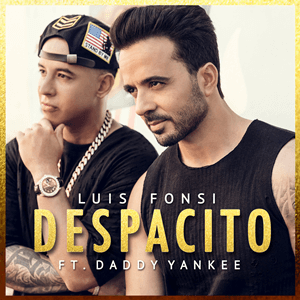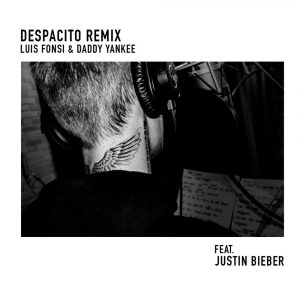
Each year, the music industry works tirelessly to synthesize a catchy melody to a song that will attain a monumental title. This title will assure that it will not only be a hit, but it will have the potential to define a generation. That title is the song of thesummer. While there are always many alluring contesters, it was clear this past summer that there was a song unlike the rest. This was not only because it wasn’t traditional “pop” music, but because it was unlike any other song produced in the United States. This song was “Despacito”. Originally, this simple word was stuck in Puerto Rican singer-songwriter Luis Fonsi’s head and as he worked with Panamanian songwriter Erika Ender and Daddy Yankee, he created what became the first Spanish crossover hit to the United States since “Macarena”.[1] It is fundamental that we examine beneath the surface of this four-minute song and consider the political implications this megahit bears and what this says about the state of American society.[2]
The Top 40 stations of the United States are not renowned for their diverse sounds and musical variety. In fact, there are very few songs on the radio that do not have the same electronic beats and repetitive lyrics. This feat is even greater, as only a few Spanish songs have made Top 40, with only three to have ever hit number one in the United States. [3]This is particularly fascinating if one is to contrast it with the Latin American radio market that is constantly dominated by American-produced songs. How is it that a song that wasn’t originally produced to be a Spanish cross-over hit reached the dimension of being the most viewed song of all time?

To understand how this song fits into our society it is important to consider the discernible details generated by the song in relation to American society. Right up front, despite the fact that 78% of the lyrics are in another language, the broad acceptance of the song is intriguing. What is it about this foreign song that has music listeners yearning for more? Is it the tropical sounds or the slowed down tempo as the song hits the melodic “des-pa-ci-to”? Or is it the fact that Justin Bieber, an idol of American Pop culture, thought the song to be absolutely infectious? To further investigate this question, it is fundamental to examine the American public’s response to this song. The reoccurring reactions are positive, describing the music as sensual and catchy. Although such descriptions are raised in other American pop songs, in “Despacito” it is done in a much subtler way because its unique feature of being in a foreign language inhibits most to analyze the lyrics in a literal manner. Hence, American listeners are drawn to the familiarity but also intrigued by the cultural differences of this masterpiece. Moreover, “Despacito” does the incredible by employing the powerful idea that fans do not need to understand the language to enjoy and appreciate music.
Nevertheless, there are an abundance of songs produced in Latin America that contain captivating and provocative melodies in Spanish, yet very few are able to attain the grand honor of American Top 40. Thus, what truly differentiates “Despacito” from other crossovers is that it is an absolute rule breaker in all senses of the word. It is impossible to truly classify the song into one genre as it is packed with several influences of reggaeton, hip-hop, dancehall, reggae, salsa, cumbia and pop. This fusion grants the song heavy beats, vocals, rap and even a swing rhythm when Justin Bieber slowly sings the word despacito at the beginning of the chorus. Subsequently, the instruments utilized are combined in an unprecedented manner. The song begins with a Cuatro guitar native of Puerto Rico, which is chopped to sound more urban. Then a guïra and guache join in, which are percussion instruments used in cumbia and merengue music. This is followed by cowbells and timbales, which are single head steel drums used in salsa music.
Additionally, the song takes an entire minute in order to arrive at the catchy melody, which is incredibly uncommon in pop music. Grasping the listener’s attention with the rich music, the song thrusts them into the adrenalizing chorus. Furthermore, the fact that the song was not originally intended to be a crossover, but was conceived once Justin Bieber contacted Luis Fonsi to become involved in the piece, is particularly unusual in the music industry. This union between Justin Bieber, Luis Fonsi and Daddy Yankee allows for there to be a synthesis of cultural and musical ideas. The musical producers of “Despacito” noted that the manner in which Justin Bieber sings the introduction is completely unexpected especially for a reggaeton-pop song, however, it is successful and revolutionary.
Thus, after having contemplated the possible reasons why Despacito reached success in the United States, it is logical to try and understand how this song fits in relation to American society. The remix of the song was released on April 17, 2017 at a time when the United States had just elected a president that called Hispanics “bad hombres” and criminals and incited sentiments of xenophobia. Hence, with its Spanish, soft and cheerful sounds, “Despacito” provided a stark contrast to the harsh realities in the country and grim news headlines. Its overwhelming popularity helps promote the advancement of Latin American culture in the United States for several reasons. First, it displays Latino culture in the forefront of American pop culture and generates important conversations about Latinos in a positive light, straying away from the negative stereotypes generated by politics and the media. Many music experts, such as Julissa Lopez from the Washington Post, pinpoint “Despacito” as havingpaved the way for other crossover Spanish songs, especially J. Balvin’s “Mi Gente”, which has now surpassed “Despacito” as number one on the Top 40 on Spotify.
This, however, does not take into consideration how the Latino community has responded to the song, which has ultimately generated mixed reactions. Some in the community have looked at “Despacito” as assurance that the United States still values Latin Americans and the diversity of American society. Yet, many have negatively received Justin Bieber’s involvement in the song as almost “colonizing” the song, essentially taking credit for the success of the song. In fact, many in popular media have declared the song to be Bieber’s when it was the contrary. What is still intriguing is that, although he did not write the song, Justin Bieber was a key piece to the puzzle of breaking into American Top 40, serving almost like a bridge amongst Latin Americans and the American public.
The music video of the song, which is now one of the most viewed videos of all time on YouTube, focuses on the island of Puerto Rico showing the beautiful beaches, people and women. It acts almost like a travel agency promo of the island, which is especially meaningful considering the current state of Puerto Rico, which is currently facing a huge debt crisis and struggling to rebuild itself after Hurricanes Maria. Although produced independently from the remix, this video became increasingly popular through the success of the remix, which generated a 45% increase in tourist interest in Puerto Rico.[4] This economic development is metaphorical forwhy the song was so triumphant, because just like Puerto Rico needs the help of the US in these times of trouble, Justin Bieber was able to help the already stunning “Despacito” achieve success in the United States.

Examining the lyrics of the song, there is a common theme of the Caribbean lifestyle, specifically the Puerto Rican life, in lyrics like “this is how we do it down in Puerto Rico”, that focus on taking it slow and enjoying each moment and step “pasito a pasito”. The message behind these lyrics could be a vital aspect of “Despacito’s” success, as it could be that many listeners are nostalgic of a slower time where they would stop and savor each moment. With industrialization and capitalism, there are very few times where we are not rushed by the different errands and jobs we have to do. “Despacito” provides a stark contrast and reminds us to slow down every once in a while, as life and love are better taken despacito.
In this case, however, by looking at how “Despacito” fits in relation to the United States, it is less likely that many Top 40 listeners were deeply analyzing the lyrics and themselves yearning for a slower life. Thus, it is important to focus on Justin Bieber’s effect and what his incorporation in the remix signifies. Despite being born in Canada, Justin Bieber is a product of the American music industry, as he was discovered at age 13 by Scooter Braun and Usher. With these adults not only supporting him, but constantly coaching him on how to handle fame and his public image, their American influence is prevalent. Justin Bieber has been in the music industry now for over 10 years with multiple Top 40 hits at only 23 years old. While he has endured countless criticisms by those that say he is simply a teenage heartthrob thriving off of teenage girls and involved in multiple encounters with the law, he is also a savvy businessman with contracts with Adidas and Calvin Klein. There is no question, however, that Justin Bieber has defined popular culture, especially through his image and music. His engagement with “Despacito” and Latin American culture and the personal decision to choose to sing the chorus in Spanish represents a major shift in ideology for Americans, especially Millennials, a group that is more drawn to diversity and to un-conventionalism.
“Despacito” was a song manufactured to signify a switch in Luis Fonsi’s music from soft pop ballads to a pop-reggaeton-esque sound; it was never intended to be a political statement, but many citizens took it to be political, especially with the current political atmosphere. With the language of Spanish currently being politicized and many Latinos being harassed – even beaten -when speaking Spanish in the United States, the popularity of this song serves as a protest to Trump’s America. This shows that our demographics are changing, and we are becoming increasingly diverse. American culture is no longer solely European-influenced culture. Additionally, the fact that Justin Bieber, a man in the music culture industry, took it upon himself to voluntarily adopt Spanish is in itself an act of political assertion. For many, Spanish is seen as the language that is invading and soiling America; however, “Despacito” defies this ideology, spanning past demographics and giving Americans something to hold on to – maybe with the slowed down lyric of “despacito”. Through this adaptation, Justin Bieber highlights the fact that America is changing, though slowly, in an ultimately refreshing way.
[1] Leight, Elias. “‘Despacito’ Singer Luis Fonsi On Surprise Spanish Smash, Bieber Blunder.” Rolling Stone, 2017, http://www.rollingstone.com/music/features/luis-fonsi-on-spanish-smash-despacito-justin-bieber-cameo-w484727
[2] This argument is adapted from Fredric Jameson’s Political Unconscious
[3] Abad-Santos, Alex. “How “Despacito” Became The Biggest Song Of 2017.” Vox, 2017, https://www.vox.com/culture/2017/8/18/16112710/despacito-biggest-song-of-2017-bieber-fonsi-daddy-yankee.
[4] “El Increíble Efecto “Despacito” En El Turismo De Puerto Rico.” Infobae, 2017, https://www.infobae.com/turismo/2017/07/03/el-increible-efecto-despacito-en-el-turismo-de-puerto-rico/.